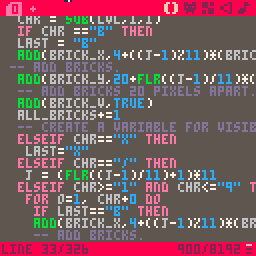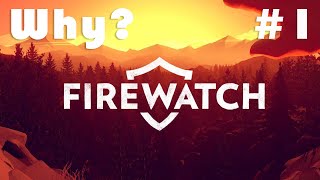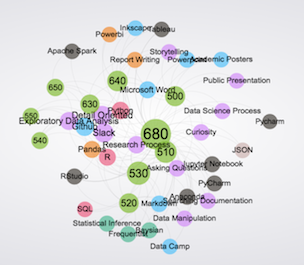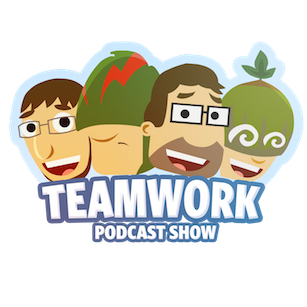Page Not Found
Page not found. Your pixels are in another canvas. Read more
A list of all the posts and pages found on the site. For you robots out there is an XML version available for digesting as well.
Page not found. Your pixels are in another canvas. Read more
About me Read more
This is a page not in th emain menu Read more
Published:
With the Coronavirus coming around, so many of us are forced indoors for a time, forced into isolation where digital tools will be forced to become the norm. We’re already seeing things like Netflix Party gain immediate popularity or exercise programs like Ring Fit Adventure sell out suddenly. I was struck by the similarities the pandemic response and social distancing has had to the year following the World Trade Center disaster. We all went inside, purchased a ton of food to make at home, and began to rethink about what was important in life. Read more
Published:
My first course with PICO-8 as an introductory space for games programming is just about complete. What went right? What went wrong? This post gets into the weeds and explores what I need to change, adjust, and transform. Read more
Published:
My relationship with games and game studies is often one of curiosity. I find the concept of ‘play’ useful yet I find that ‘play’ is more useful to study something else than it is to study games themselves. Despite this, I do try to keep an eye on games and game studies. There is always so much stuff to watch, so many authors to keep track of, and so many academic moves to remember. Read more
Published:
What is code? Why do we write it in PICO-8? What does that mean? Read more
Published:
Fantasy Consoles are self-contained video game development environments so incredibly constrained that users have no choice but to learn how programming works. Read more
Published:
Or how we all want to stay home instead of go on adventures. I wrote this introductory bit for my dissertation and i’m not sure it will stick with it so I thought i’d put it here. Read more
Published:
I got some reviews back the other day on my first attempt to produce something from my dissertation research. Of the reviews, one aspect that stood out was that there was a need for “more detail.” Simple associations like those found in Social Network Analysis just aren’t enough for something substantial. And, for the most part, I agree. Read more
Published:
In early 2014, I began to lay the groundwork for a simulation meant to train crisis management personnel on the growing impact of social media during response efforts. Later, this work would make its way into a proposal submitted on behalf of the Netherlands Organization for Applied Scientific Research (TNO) meant to do just that. Our proposal outlined the need and benefit of a simulation that was created to be engaged in-person, was low fidelity, low technology, and meant for for resource strapped crisis management services in rural portions of the European Union. Simulations like these are invaluable for all manner of training. Read more
Published:
In Austin, Texas about 6 or 7 years ago there was this strange rebirth of alternate ways of making and riding bicycles. Most would associate this with the generally weird and purposefully alternative atmosphere that makes Austin…weird. But as these bikes rode around town, people began to talk about how nostalgic these bikes were. It was as if they came from a different time, a time when the bicycle may have had a different future, a different look. It is with this nostalgia that we take a different sort of trip to a place where the future of video games could have been a different one. In this future, we will begin with Ian Bogost’s A Slow Year. Read more
A course I created to help interested people learn a little bit about how computer programming works.  Read more
Read more
It is difficult to reach students at times. They are busy and the frustration of learning that much of their consumer behavior is not from choice but marketing is difficult to accept, let alone teach. I have constantly tried to find new and exciting ways to think about how to approach students in this way. This attempt was somewhat successful but difficult to attend to due to my own schedule. I wanted to try to make some super brief videos that captured a level of criticism that would speak to students in design programs. The result was the creation of 5 minute briefs about why designers should care about things they might not notice normally.
 Read more
Read more
Data Science is new and weird and doesn’t always make sense. Much of the information that is out there is contradictory as well as dense and difficult to parse. For the advising team at Bellevue University, I started to collect a number of skills, concepts, and programs that students would learn in the program I created. I then mapped each of these to their respective courses and stuck it inside of NodeXL and then a Gephi compatible file. The result should be useful enough for students and advisors.
 Read more
Read more
Many years ago, a colleague from the Cologne Game Lab in Cologne Germany asked me to start a podcast so that we could learn how to edit, broadcast, and capture video and audio.  Read more
Read more
Published in Masters Thesis, 2014
The influence of the 9/11/01 attacks are still being felt in entertainment media today. Here is a systematic evaluation of the “big bad” in video games over time. Read more
Download here
Published in Conference Proceedings, 2014
Reddit and 4Chan had a tremendous impact on the Boston Marathon Bombing investigation. We can trace that impact. Read more
Download here
Published in International Journal of Information Systems for Crisis Response and Management, 2014
In this paper we illustrate the ethical dilemmas that arise when large public investigations in a crisis are crowdsourced. We focus the variations in public opinion concerning the actions of two online groups during the immediate aftermath of the Boston Marathon Bombing. Read more
Download here
Published in Conference Proceedings, 2015
To help increase the accuracy and timeliness of auroral forecasting, we have designed a multi-faceted system called Aurorasaurus. This system allows crisis management specialists to test reactions to rare event notifications. Read more
Download here
Published in Studies in Symbolic Interaction, 2015
The concept of the music scene has served sociologists well in providing a template for studying the organization of various musical styles and the people who work together to create the musical experiences Read more
Download here
Published in Conference Proceedings, 2015
We present Aurorasaurus: a website, a mobile application, and a citizen science initiative that allows a community of users to report and verify sightings of the Aurora Borealis. Read more
Download here
Published in Information, Communication & Society, 2015
Sociology has long been criticized for not incorporating tools, imbued with power and the ability to interact as nonhuman, into its basic research paradigms. Read more
Download here
Published in Sustainable and Resilient Infrastructure, 2017
This paper was the start of trying to seek out existing data for reuse as sensors. Read more
Download here
Published in Conference Proceedings, 2018
A primary component of disaster response is training. These educational exercises provide responders with the knowledge and skills needed to be prepared when disasters happen. However, traditional training methods, such as high-fidelity simulations (e.g., real-life drills) and classroom courses, may fall short of providing effective and cost-efficient training that is needed for today’s challenges. Read more
Download here
Published in Dissertation, 2018
It is possible to use Social-Network Analysis to reify Actor-Network Theory. By including non-human actors in the analysis of software use, all of the disparate applications, devices, tasks, and contexts can be made explicit, numerically represented, and tested against or with similar networks. I demonstrate AM by creating Association Maps for 6 games of the board game Catan (1995) – a dice-based game of resource distribution and management. Catan (1995) was chosen for this pilot study due to its popularity, affordances, and expected behaviors. Read more
Download here
Published in ACM Transactions on Computer-Human Interaction, 2019
We trace the history of game map interfaces from their paper-based inspiration to their current smart phone-like appearance. Read-only map interfaces enable players to consume maps, which is sufficient for wayfinding. Game cartography interfaces enable players to persistently modify maps, expanding the range of activity to support planning and coordination. Read more
Download here
Published in Emergency and Disaster Management: Concepts, Methodologies, Tools, and Applications, 2019
In this paper the authors present a system that aims to provide real-time data to emergency managers during a crisis event in such an environment – a college town during a football game or similarly attended event. The system is designed to accept, sort, triage and deliver hundreds of direct text messages from populations engaged in a crisis to emergency management staff who can respond. They posit that when a municipal or county-level EOC is cross-housed with a University EOC, multiple opportunities for development and funding occur. Read more
Download here
Published in Analog Game Studies, 2019
This essay narrows the gap between analog1 and digital games by connecting Dungeons and Dragons (1974) or D&D to the origins of the video game industry. Despite its analog status, D&D is a video gaming platform much like a Nintendo Switch, Mattel Intellivision, or the Atari Lynx. In fact, it is the first platform, or environment that programming can be performed on2. D&D was formed of the same military logic as programming languages and shared a release date with the first computers available for public use.3 Read more
Download here
Published in Halfway to the Future, 2019
Search and rescue (SAR) operations are often nearly computer-technology-free due to the fragility and connectivity needs of current information communication technology (ICT). In this design fiction, we envision a world where SAR uses augmented reality (AR) and the surplus labor of volunteers during crisis response efforts. Read more
Download here
Published in Proceedings of the 53rd Hawaii International Conference on System Sciences., 2020
In April of 2013, two pressure cooker bombs detonated near the finish line of the Boston Marathon. The resulting crowdsourced criminal investigation has been subject to intense scrutiny. What has not been discussed are the offering behaviors of Twitter users immediately following the detonations. The hashtag #BostonHelp offers a case study of what emergent, computer-mediated groups offer victims of a crisis event. Through creative appropriation of at-hand technologies (CAAT), this emergent group organized online offering and information about tangible resources on the ground. Read more
Download here
Published in Proceedings of the 2020 ACM Designing Interactive Systems Conference, 2020
Game map interfaces provide an alternative perspective on the worlds players inhabit. Compared to navigation applications popular in day-to-day life, game maps have different affordances to match players' situated goals. To contextualize and understand these differences and how they developed, we present a historical chronicle of game map interfaces. Read more
Download here
Published:
This research attempts to explore the role of women as characters in video games that are created by a majority of designers and programmers who are raised in the United States. Before I approach the idea of women in a video game, there is a distinction that must be made: computer games and video games. A video game is played through a dedicated console (Xbox, Playstation) connected to a television. A computer game is played through a computer connected to a computer monitor (Peuter 2007). It is useful to separate the two because until recently, a majority of video games came from Japan whereas computer games stayed mostly in America. However, the American computer game culture was as such that it was associated with the derogatory, socially isolated, nerd culture and was mostly ignored (Leonard 2004). It was not until video games began to be printed on the CD-ROM that American created video games began to reappear as the culture producing the hardware was the same culture producing the software – also known as ‘cultural proximity’ (Aoyama & Izushi 2003, p. 435). The release of the Microsoft Xbox 360 seems to have signaled a new era in which the rift created in the 80s between video games and computer games is mended. With it, the cultural proximity or, the closeness of culture of video games has once again begun to display relevant cultural norms to examine from the American perspective from hardware to display. Read more
Published:
Values Levers are defined as design “practices that open new conversations about social values and encourage consensus around those values as design criteria.” One values lever that is often unnoticed is that of white nationalist appropriation. White Nationalists are often “othered” as extremists which obfuscates rhetoric around racism. In return, levers about race are only pulled during the design process if it is overt in its racial sensitivity. We often refer to this as political correctness or more appropriately “racism without racists [1].” This research represents one case study of the unintended white nationalist appropriation of content within The Elder Scrolls: Skyrim. By building on a discussion originated by white nationalists, we hope to pull a values lever that approaches multi-cultural and multi-national content that doesn’t focus on racism as an extremist activity but an unintended consequence of well-intended design. Read more
Published:
Pen and Paper-based simulations (or wargames) were a staple of the classroom until the early 1980s. From Chess to Diplomacy, the tabletop was a useful way to educate about finer points of conceptual environments. The computer simulation, while less time consuming, hides many procedures from the user. Emergency Response is replete with all manner of concepts that are difficult to teach through computer simulation. As such, educators need to look backward to simulations created before the computer age and combine them with automated social media content for a more sophisticated means through which to educate or train students. By combining electronic communication with 1970s inspired wargames, this project intends to create a hybrid simulation for educators to use in the classroom. Its intent is to simulate what can cause an emergency response to a disaster to go well both in the public eye and for those impacted by the event. Read more
Published:
The computer is an institution much like the societies and cultures that birthed it – disjointed, hegemonic, asymmetric in their understanding of what the computer is for, and trapped in the ontology of the language computation was designed through - English. This mishmash of development we call a computer has followed a singular path since the personal computer was released in the early 1980s and has grown to a near ubiquitous state (Dourish, 2004). In fact, it is now nearly impossible to escape the metaphor of the computer in everyday life (Curtis, 2004). We have become hybrid yet, for the most part, we still try and separate the world inside the computer – the virtual world – and the world outside of it – the real world. When we install the concept of games and play into this dialectic, we see a mimesis. Read more
Published:
Within the popular video game, The Elder Scrolls: Skyrim players can discover a number of references, consciously included or not, to the search for the Arryan race performed in Europe during the late 1800s. Within the game, books, character quotes, and narrative foundations trace the original scientific discussion that formed the basis for present day Neo-Nazi, White supremacist, and White nationalist movements. With that in mind, this research presents a casestudy of a confrontation between a virtual community, the members of the Stormfront web forum, and a video game, The Elder Scrolls: Skyrim. Members of the Stormfront community indicated that an unwanted degree of multiculturalism was present inside the game despite its being closely aligned to their belief system and omni-present political struggle. The resulting forum-based discussion presents a unique opportunity to examine how virtual or procedural rhetoric interacts with the world writ large. From using the game as an opportunity to recruit new members to a discussion of how the various races of Tamriel have changed in appearance through each iteration, the resulting discussion displays the sensitivity this group has to appearance and how the boundaries of that sensitivity are maintained. Through discourse analysis of posts in a thread on Stormfront paired with game creator discourse ininterviews, wikis, and press releases, this research examines how matters of race are expressed within and about The Elder Scrolls: Skyrim. Slides Located Here Read more
Published:
Aurorasaurus offers a unique interpretation of Citizen Science. Most citizen science projects seek participants to gather data. We attempt to use the data that already exists to pinpoint the location of the Auroras themselves. Read more
Published:
Academic posters can be a real nightmare to read. Researchers pour their heart and soul into their work, into their research but at the last second, they have to do something they’ve not considered before, talk to someone about it. This workshop will walk you through some ideas and considerations about making academic posters. Examples, theories, and methods to creating good posters as well as examples, theories, and methods for how bad posters are created will also be covered. Read more
Published:
When players are immersed in a video game world, the map serves as a way for designers to provide scale and foster player behaviors like exploration. Over time, video games have moved from 2-dimensional, flat, tightly bound worlds to 3-dimensional, open worlds. The map has undergone a concomitant transition from the literal space of play to an abstract object that must be consulted in a separate space from play, offering its own interactive affordances. We offer a history of what we term “game cartography interfaces” – the space where players view and possibly interact with a gameworld’s map. We begin with a discussion of mimesis and transmedia practice from the early history of video games (e.g., Zork, Rogue). In these games, players were tasked with drawing maps on their own, since technology was insufficient to facilitate mapping in-game. We continue with a discussion of computer roleplaying games like Ultima, Final Fantasy, and DragonQuest. Here, the map could sometimes be viewed as an object but it was primarily also the space of play. We conclude with a discussion of the impact of 3D games like The Legend of Zelda: Breath of the Wild, Guild Wars 2, and Arma 3. These robust, large-scale game worlds provide players with a separate space to deeply manipulate a game map. The use of outside knowledge from smartphone mapping applications and the need for online play provide a useful discussion about the re-interpretation of transmedia mapping practices without technical limitations. Read more
Published:
The rise of toxic gaming culture occurs in concurrence with the slow loss of technological affordances that promote sociality and cooperation in Massively Multiplayer Online Role-playing Games (MMORPG). Between 2004 – 2013, World of Warcraft slowly removed the need for players to interact with one another. This resulted in other MMORPGs following suit with existing MMORPGs left to figure out how to deal with this new style of play. This case study examines the patch notes and software history of the popular MMORPG called Final Fantasy XI Online (FFXI). This MMORPG is unique as it was a game whose systems forced cooperation and reliance on other people. How FFXI changed from forced human-to-human reliance to a single-player experience is a unique case study reflecting the broader design trends in socially-oriented online play. By explicating these features, this case study provides useful context the study of the loss of cooperation and sociability in online gaming. Paper Located Here Read more
Published:
We live like Robinson Crusoe in Michel Tournier’s satire Friday, the Other Island. After being washed ashore on an empty island, Robinson Crusoe rebuilt the socio-technical system he belonged to. As he strengthened that system, he came to find the pressure of maintaining it so burdensome that when it was destroyed, he felt freedom for the first time. The pressure to maintain our systems is so powerful that the physiological impact of that pressure lowers life expectancy for people different than Crusoe. Every method we use to study our systems adds pressure. Every design adds to that pressure. We wait, much like Crusoe, over-burdened and desperate; waiting to be rescued from ourselves. With rescue impossible, do we simply keep building pressure until Friday (thankfully) blows it all up? Perhaps we can learn Friday’s lesson without all that violence. Read more
Published:
Software development and computational power have developed and changed so quickly that much of the research surrounding it are reactions, a result of the computer reaching out. The consequences of this constant change are that historic contexts, including the ability to understand the code and procedure of the time is often lost to newer, more efficient, yet incompatible technologies. This project will approach software preservation beyond archival purposes. We will evaluate the code these programmers in concurrence with the human activity those coders were seeking to translate: the tabletop game Dungeons and Dragons (D&D). A team of historians, computer scientists, humanists, and enthusiasts will work to develop a method that simultaneously examines the code of five early video games: dnd, pedit5, moria, Oubliette, Adventure, and Beneath Apple Manor. The result will be a procedural examination of some of the earliest video games created by some of the earliest students of programming, their difficulties, and procedural decisions, some of which are in use to this day. Read more
Undergraduate course, Pennsylvania State University, Information Sciences and Technology, 2017
My time as a graduate student at the Pennsylvania State University was also spent teaching and learning about various aspects of project development. My first semester was an interesting experience as I led a team of undergraduate learning assistants and served as a managed of 27 teams in a 170 student course. Later, I was awarded a teaching position as a graduate student and taught students from all over the university about HTML and CSS. This work would introduce me to teaching large courses in-person, a skillset I was lacking from my time teaching online courses at Bellevue. Read more
Undergraduate Courses and Graduate Courses, Bellevue University, College of Sciences and Technology, 2018
At Bellevue University, I have been involved with Data Science, Game Design, Graphic Design, and Business Analytics. As current director of the Data Science program, I have sought to create a program that fosters human-centric, critical and curious thinkers who are capable of telling unique, easy to understand stories. This program is domain agnostic but students are free to use data from their respective fields as needed. Read more
Graduate Courses, University of Illinois at Urbana Champaign, School of Information Sciences, 2018
I began as an adjunct at the School of Information Sciences at the University of Illinois at Urbana Champaign in the Fall of 2017. Currently, I have been responsible for 2 courses in the Masters of Science in Information Management program. Those two courses, Foundations of Information Processing and Socio-Technical Information Systems are as inverse of courses as possible. It has been tremendously exciting to teach these courses in person and online. Read more
Undergraduate, University of Nebraska at Omaha, College of Information Science and Technology, 2022
Description Read more